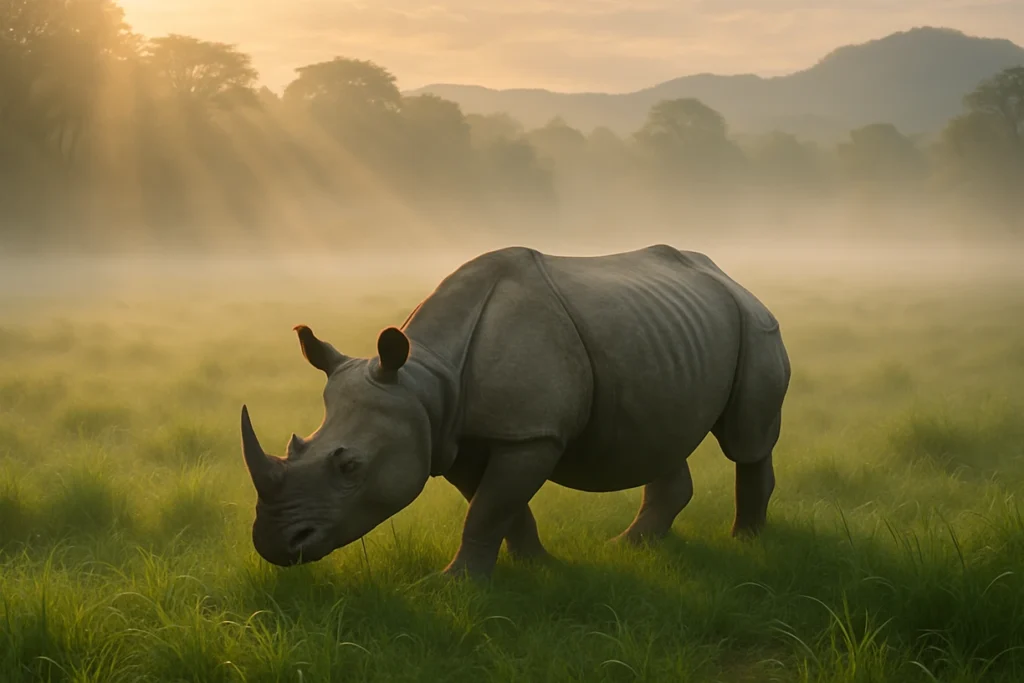
Gorumara National Park, a verdant jewel in the Dooars region of West Bengal, is most famous for its remarkable success in conserving the Indian one-horned rhinoceros. This protected sanctuary, nestled in the Himalayan foothills, offers more than just a glimpse of this magnificent creature; it is a thriving ecosystem of lush grasslands, dense forests, and meandering rivers.
Visitors are drawn here not only for the thrilling wildlife encounters but for the immersive experience of nature’s raw beauty and the region’s rich cultural tapestry. This guide serves as your definitive resource, moving beyond basic facts to offer a truly inspiring blueprint for your adventure.
This comprehensive post will guide you through every aspect of planning your visit. We’ll delve into the park’s incredible biodiversity, its celebrated conservation story, and the vibrant local culture. Moreover, you’ll find practical, consolidated travel advice to make your journey seamless and unforgettable.
Table of Contents
- Gorumara: A Thriving Biodiversity Hotspot
- The Majestic Indian One-Horned Rhinoceros
- The Gentle Giants: Asiatic Elephants
- The Mighty Gaur (Indian Bison)
- A Paradise for Birdwatchers
- The Gorumara Conservation Success Story
- Your Gateway to Wildlife: Watchtowers and Safari Routes
- Thrilling Jeep Safaris
- A Unique Perspective with Elephant Safaris
- Must-Visit Watchtowers for Prime Viewing
- Immersing in Local Culture: The Heart of the Dooars
- The Ultimate Gorumara Travel Planner
- Best Time to Visit Gorumara National Park
- How to Reach the Park
- Accommodation Options: From Resorts to Forest Bungalows
- Essential Visitor Tips for an Enriched Experience
- Beyond the Safari: Other Activities in and Around Gorumara
- Practicing Responsible Tourism in Gorumara
- Frequently Asked Questions (FAQ) about Gorumara National Park
- Conclusion: Your Adventure Awaits
Gorumara Nature Park: A Thriving Biodiversity Hotspot
Designated a Reserve Forest in 1895 and later a National Park in 1994, Gorumara’s landscape is a vibrant mosaic of forests and riverine grasslands.[1] This rich environment supports an astonishing array of life.
The park is home to approximately 50 species of mammals, over 200 species of birds, 22 species of reptiles, and 7 species of turtles.[1][2] Its importance was officially recognized when the Ministry of Environment and Forest declared it the best-protected area in India in 2009.[3][4]
The Majestic Indian One-Horned Rhinoceros
The undisputed star of Gorumara National Park is the Indian one-horned rhinoceros. Thanks to exemplary conservation efforts, the park provides a safe haven for a significant breeding population of this vulnerable species.[1]
These magnificent animals, often seen grazing peacefully in the grasslands or wallowing in mud pools, are a testament to one of India’s greatest conservation success stories. Spotting a rhino, with its armour-like skin and prehistoric presence, is a truly humbling experience. They are often best viewed from the park’s strategically placed watchtowers, especially near salt licks and water bodies.[2]
The Gentle Giants: Asiatic Elephants
Gorumara is also a crucial corridor for the Asiatic elephant. Herds of these intelligent and social animals roam through the forests and grasslands. Consequently, witnessing a herd crossing a river or a mother tenderly guiding her calf is a powerful and unforgettable sight. The park’s management of human-elephant conflict is an ongoing effort, highlighting the delicate balance required for coexistence.[5]
The Mighty Gaur (Indian Bison) In Nature Park
The Gaur, or Indian Bison, is another of the park’s formidable residents. As the largest species of wild cattle in the world, their muscular build and impressive horns command respect. These herbivores are often seen in herds grazing in the open grasslands. Their presence adds to the thrilling sense of wilderness that defines the Gorumara experience.
A Paradise for Birdwatchers At Eco-Tourism Site
For avian enthusiasts, Gorumara is nothing short of a paradise.[2] The park’s diverse habitats attract a stunning variety of birds. Some of the notable residents you can spot include the majestic Great Indian Hornbill, the vibrant Scarlet Minivet, Spangled Drongo, and numerous species of woodpeckers and pheasants.[6][7]
The Chukchuki Watchtower is particularly renowned as a prime spot for birding, offering a tranquil setting to observe both local and migratory species.[2][8]
The Gorumara Jungle Reserve Conservation Success Story

The story of Gorumara is one of triumph. Once a small reserve forest, its journey to becoming a national park is intertwined with the successful revival of the rhino population.[1][9] In the early 1980s, the number of rhinos was critically low.
However, through dedicated anti-poaching measures, habitat restoration projects, and, crucially, the strong involvement of local communities, the population has seen a remarkable recovery.[10][11]
This collaborative conservation model, where local villagers work alongside wildlife personnel, is a key differentiator.[10] Eco-development committees and the sharing of tourism revenue have empowered local communities, turning them into staunch protectors of the park’s wildlife.
This success has made West Bengal the state with the second-largest rhino population in India, a powerful narrative that inspires responsible and conscious tourism.[12] The Indian Rhino Vision 2020 program has been instrumental in this achievement, showcasing a conservation model for the world.
Your Gateway to Wildlife: Watchtowers and Safari Routes

Exploring the depths of Gorumara National Park is an adventure made accessible through well-organized safaris and strategically located watchtowers. It is important to remember that the park remains closed during the monsoon season, typically from June 15th to September 15th.[3]
Thrilling Jeep Safaris
The most popular way to experience the park’s core areas is via a jeep safari. These rides take you through varied terrains, from dense forests to open grasslands, optimizing your chances of wildlife sightings.
For a deeper dive into what these adventures entail, consider exploring a detailed guide on the Gorumara Jungle Safari. Safaris are available in several time slots throughout the day, with early morning and late afternoon being the most rewarding times.[3]
A Unique Perspective with Elephant Safaris In Jungle Reserve
For a truly unique and intimate wildlife experience, the elephant safari is unparalleled. Riding atop these gentle giants allows you to venture into parts of the forest inaccessible to jeeps, offering a different vantage point.[3]
The quiet movement of the elephant causes less disturbance to other animals, often resulting in closer encounters. You can learn more about this incredible experience by checking out information on the Gorumara Elephant Safari.
Must-Visit Watchtowers for Prime Viewing
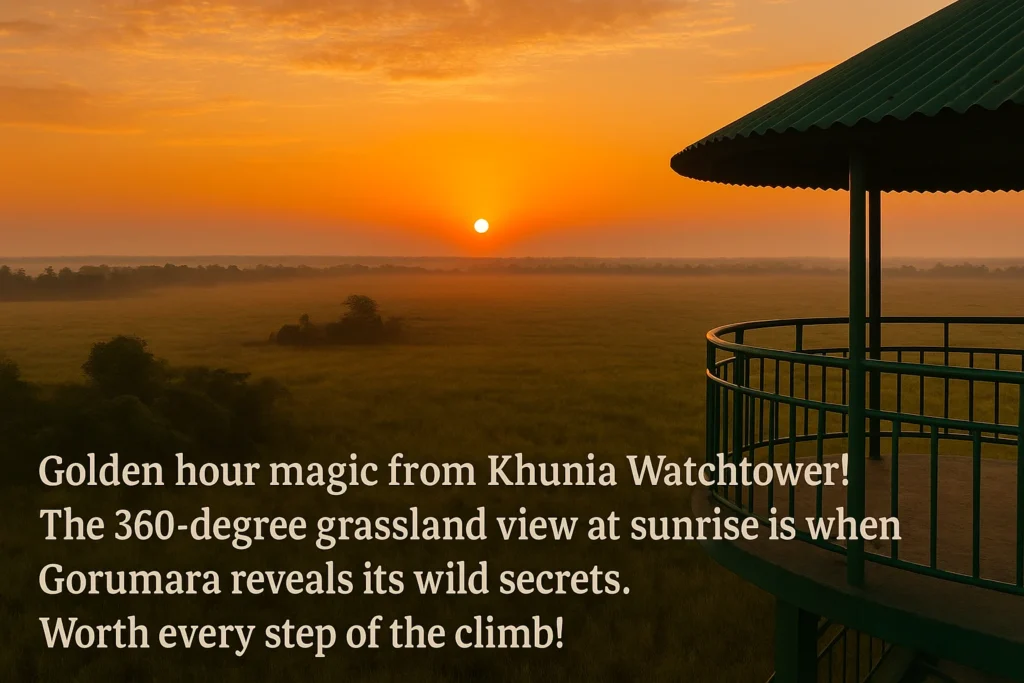
Gorumara is famed for its watchtowers, each offering a unique perspective of the wilderness.[13]
- Jatraprasad Watchtower: Named after a legendary park elephant, this is the oldest and most famous watchtower, offering panoramic views of the forest and a nearby salt lick.[2][3]
- Medla Watchtower: Located near the Murti River, this tower is unique as you reach it via a buffalo-drawn cart ride, providing a rustic and memorable experience.[2][3]
- Chukchuki Watchtower: A haven for birdwatchers, this tower is situated in a quieter part of the park, perfect for spotting various avian species.[2]
- Chandrachur Watchtower: Also known as Khunia Watchtower, this spot is excellent for sighting elephants and gaur.[2]
Immersing in Local Culture: The Heart of the Dooars
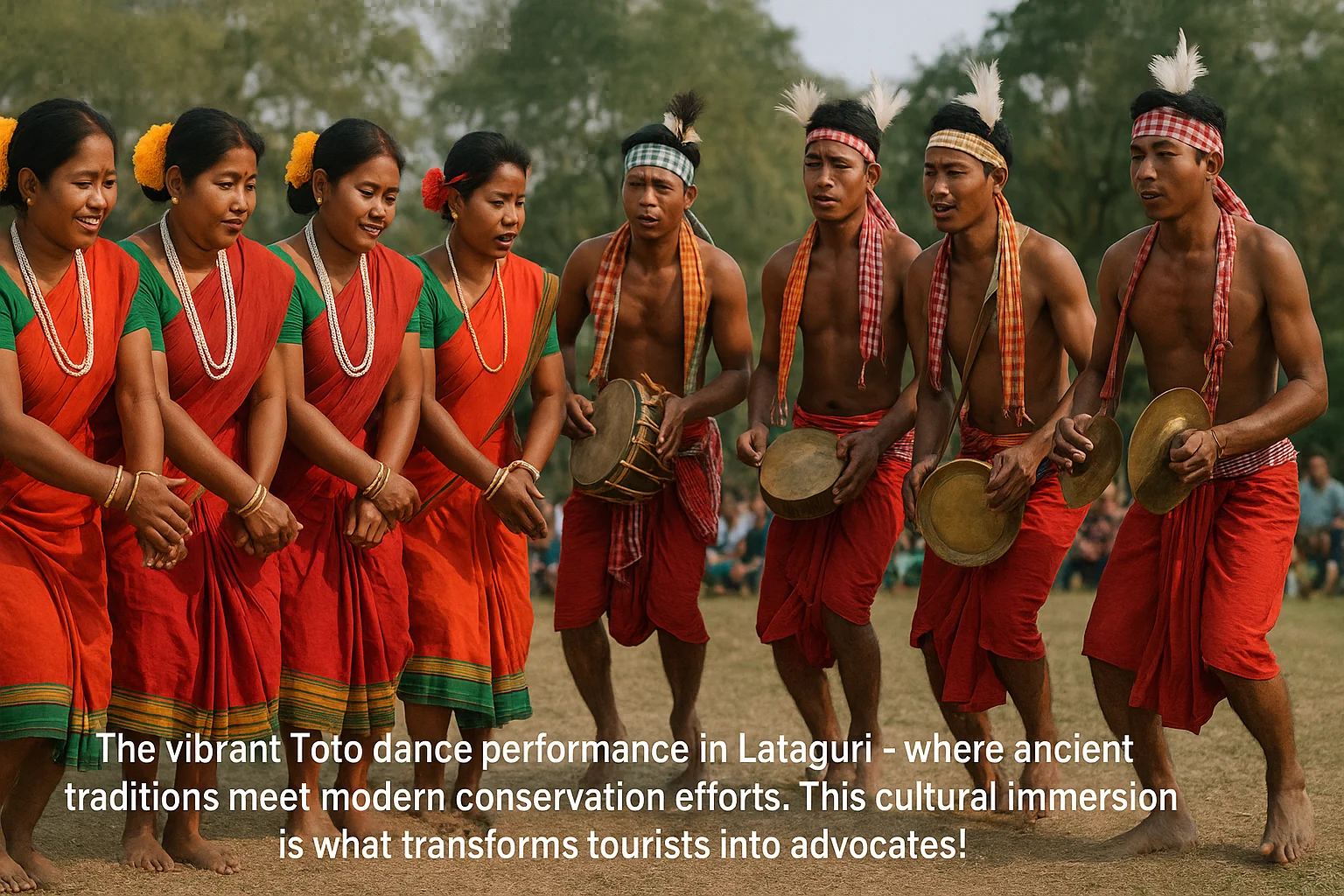
A visit to Gorumara extends beyond its wildlife; it is an opportunity for profound cultural immersion. The areas surrounding the park are home to several indigenous tribal communities, including the Rabha, Oraon, and Toto tribes.[9][14] These communities have a deep, centuries-old connection with the forest.
Many resorts and local bodies organize cultural programs featuring vibrant tribal dances and music, offering a fascinating glimpse into their heritage.[14]
Engaging with these communities, perhaps by visiting a local village or purchasing their beautiful handicrafts, provides a richer, more authentic travel experience. This interaction not only supports the local economy but also fosters a deeper appreciation for the human element of this incredible landscape.
The Ultimate Gorumara Travel Planner
One of the biggest challenges for visitors is fragmented information. This section serves as your consolidated, practical guide to planning a seamless and memorable trip to Gorumara National Park.
Best Time to Visit Gorumara National Park
The ideal time to visit is from November to March.[2] During these months, the weather is pleasant and dry, making it perfect for safaris and increasing the chances of wildlife sightings.[15][16] The park remains closed during the heavy monsoon season, from mid-June to mid-September.[2][3]
How to Reach the Nature Park
- By Air: The nearest airport is Bagdogra Airport (IXB) in Siliguri, located approximately 80-90 km away.[4][15] From the airport, you can easily hire a taxi for the scenic 2-hour drive to the park.
- By Rail: The closest convenient railway station is New Mal Junction (NMZ), about 20 km away.[4][17] The major hub of New Jalpaiguri (NJP) is about 58-75 km away and offers excellent connectivity to the rest of the country.[3][4]
- By Road: Gorumara is well-connected by road from Siliguri and other parts of North Bengal. The roads are generally in good condition, making for a comfortable drive.[15][17]
Accommodation Options: From Resorts to Forest Bungalows
A wide range of accommodation is available near the park, primarily in the Lataguri and Murti areas.[18] Options cater to all budgets, from luxury resorts with modern amenities to cozy, budget-friendly lodges and government-run forest bungalows.[19][20] Staying in an eco-resort can enhance your experience, as many are designed to blend with the natural surroundings.
Essential Visitor Tips for an Enriched Experience

- Book in Advance: Safaris and accommodations can fill up quickly, especially during peak season. It is highly advisable to book everything in advance.[21]
- Carry Essentials: Pack binoculars for better wildlife viewing, a good camera with a zoom lens, comfortable clothing in neutral colours, mosquito repellent, and a light jacket for cool mornings.[21][22]
- Hire a Guide: An experienced local guide is invaluable. Their knowledge of the terrain and animal behaviour can significantly increase your chances of spotting wildlife.[22]
- Follow Park Rules: Always maintain a safe distance from animals, do not feed them, and remain quiet during safaris. Littering is strictly prohibited.[22][23][24]
Beyond the Safari: Other Activities in and Around Gorumara
While safaris are the main attraction, the region offers more to explore. You can spend time at the Murti River, a scenic spot perfect for picnics and leisurely walks.[21] The adjacent Chapramari Wildlife Sanctuary is another excellent destination for wildlife lovers.[3][15]
For those interested in a broader regional experience, Gorumara serves as a perfect gateway to exploring the incredible natural beauty of the Dooars. Embracing eco-tourism in Dooars allows for a deeper connection with the entire region’s unique landscapes and conservation initiatives.
Practicing Responsible Tourism in Gorumara Nature Park
As a visitor, you play a crucial role in the preservation of this delicate ecosystem. Adopting sustainable practices ensures that the park remains a sanctuary for generations to come.
- Minimize Your Footprint: Avoid using single-use plastics and dispose of all waste responsibly.[24]
- Support Local Communities: Hire local guides, buy authentic handicrafts, and stay in locally-owned eco-resorts.
- Respect Wildlife and Culture: Maintain silence in the forest, never disturb the animals, and be respectful when interacting with local communities.[22]
By travelling consciously, you contribute directly to the conservation efforts that make Gorumara so special.
Frequently Asked Questions (FAQ) about Gorumara National Park
Q1: Is Gorumara National Park worth visiting?
Absolutely. It is famous for its large population of the Indian one-horned rhinoceros and offers a rich biodiversity, beautiful landscapes, and a unique cultural experience. Its conservation success story alone makes it a compelling destination.[3]
Q2: How many days are enough for Gorumara?
A 2 to 3-day trip is ideal. This allows enough time for multiple safaris at different times of the day, a visit to a watchtower or two, and some local cultural exploration.
Q3: What is the best safari in Gorumara?
Both jeep and elephant safaris offer unique experiences. Jeep safaris cover more ground, while elephant safaris offer a quieter, more intimate encounter with nature. Many visitors choose to experience both.[3]
Q4: Which animals are found in Gorumara National Park?
The park is home to Indian rhinos, Asiatic elephants, gaur (Indian bison), leopards, sloth bears, various species of deer (like sambar and chital), and over 200 species of birds.[2][7]
Conclusion: Your Adventure Awaits
Gorumara National Park is far more than just a wildlife destination; it is an inspiring testament to the power of conservation and community. It’s a place where thrilling wildlife encounters, serene natural beauty, and rich cultural heritage converge to create an unforgettable experience. This guide provides the blueprint, but the real adventure begins when you step into the lush grasslands and hear the symphony of the forest. Plan your visit, travel responsibly, and prepare to be captivated by the wild heart of West Bengal.
Sources help
- wildbengal.com
- northbengalguide.com
- northbengaltourism.com
- northeast-india.in
- isca.in
- gorumaranationalpark.com
- experiencehimalaya.com
- dooars.info
- gorumaranationalpark.com
- cambridge.org
- researchgate.net
- getbengal.com
- wikipedia.org
- gorumaranationalpark.com
- thefireflyresorts.com
- gorumaranationalpark.com
- thetourindia.com
- hotels.com
- makemytrip.global
- travelocity.com
- dooars.travel
- gorumaranationalpark.com
- travelsetu.com
- rstravels.co.in

——————————————————————
- Paragliding in Vagamon: The Ultimate 2025 Sky-High Guide
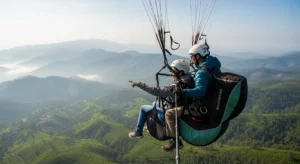 This comprehensive guide details paragliding in Vagamon, India, highlighting it as a premier global destination due to its ideal flying conditions and stunning natural landscapes of tea gardens and rolling hills. The source provides a step-by-step overview of the tandem paragliding experience, from booking to landing, emphasizing rigorous safety protocols and the expertise of certified pilots. It also covers practical information such as the best seasons to fly, costs, eligibility requirements, and what to wear, ensuring a well-prepared and exhilarating adventure. Beyond the flight itself, the guide encourages visitors to explore other local attractions, making the trip a more complete experience.
This comprehensive guide details paragliding in Vagamon, India, highlighting it as a premier global destination due to its ideal flying conditions and stunning natural landscapes of tea gardens and rolling hills. The source provides a step-by-step overview of the tandem paragliding experience, from booking to landing, emphasizing rigorous safety protocols and the expertise of certified pilots. It also covers practical information such as the best seasons to fly, costs, eligibility requirements, and what to wear, ensuring a well-prepared and exhilarating adventure. Beyond the flight itself, the guide encourages visitors to explore other local attractions, making the trip a more complete experience. - The Engineering Marvel: Vagamon’s Glass Bridge
 The Vagamon Glass Bridge is India’s longest cantilever glass skywalk, and the text below gives a full description of it. It talks about the cantilever design, the difficult problems that come with building at a high altitude, and the creative use of multi-layered glass for safety, which are some of the bridge’s engineering wonders. The source also gives advice to people who are terrified of heights and sums up the tourist experience, focussing on how strange it is to walk on a platform that you can see through. It also talks about how the bridge cares about the environment and how it helps the local economy through tourism, making it a prominent emblem of sustainable adventure tourism in Kerala.
The Vagamon Glass Bridge is India’s longest cantilever glass skywalk, and the text below gives a full description of it. It talks about the cantilever design, the difficult problems that come with building at a high altitude, and the creative use of multi-layered glass for safety, which are some of the bridge’s engineering wonders. The source also gives advice to people who are terrified of heights and sums up the tourist experience, focussing on how strange it is to walk on a platform that you can see through. It also talks about how the bridge cares about the environment and how it helps the local economy through tourism, making it a prominent emblem of sustainable adventure tourism in Kerala. - Mastering the Vagamon Zipline: Your Ultimate First-Timer’s Guide
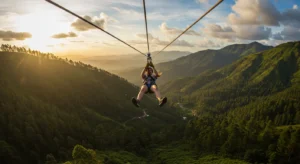 Mastering the Vagamon Zipline is easy with our guide! Learn about safety, weight limits, what to wear, and what to expect. Book your thrilling adventure today
Mastering the Vagamon Zipline is easy with our guide! Learn about safety, weight limits, what to wear, and what to expect. Book your thrilling adventure today

Mentions